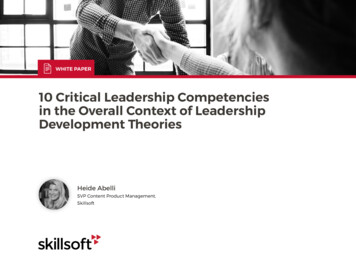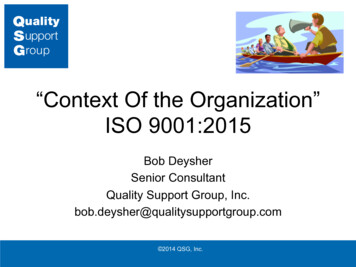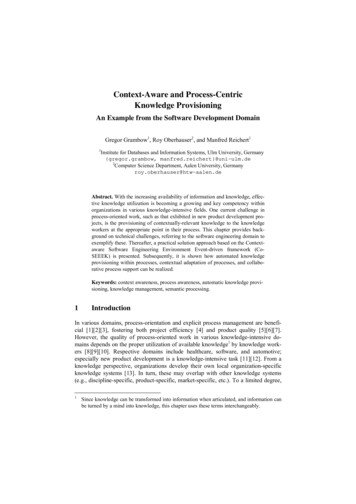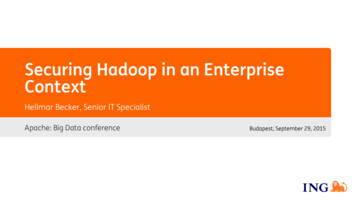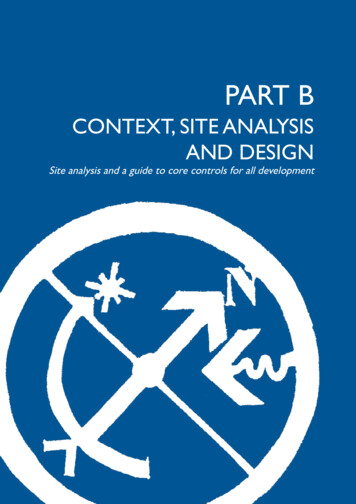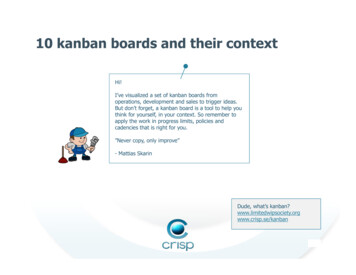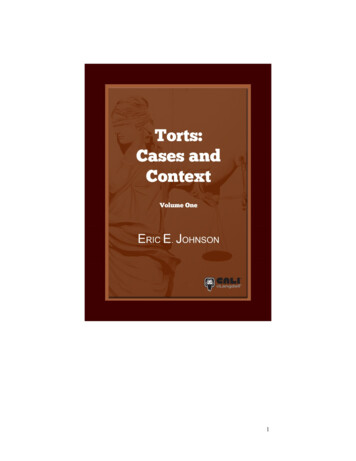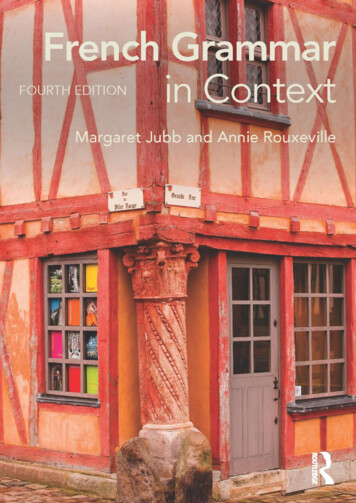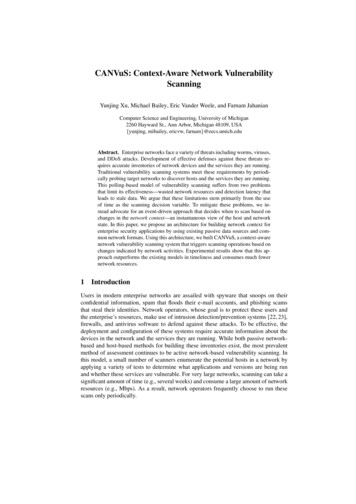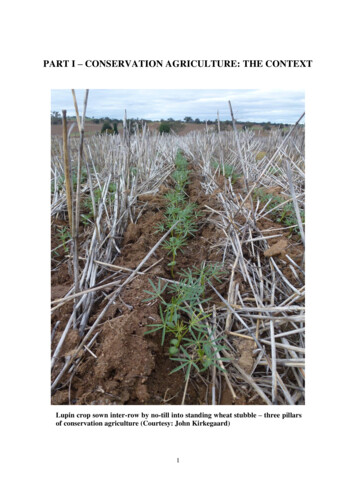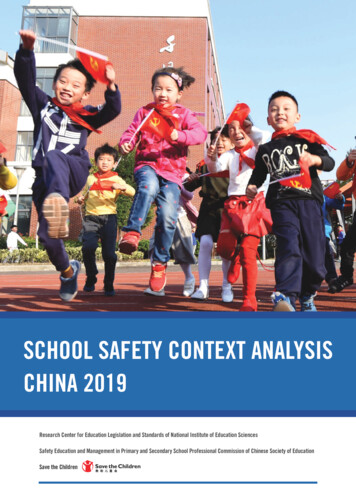
Transcription
Role and Implementation ofElectronic Portfolios:Digital Stories and Web 2.0Based on 2 papers on my website AuthenticAssessment withElectronic Portfolios using CommonSoftware and Web 2.0 Tools– http://electronicportfolios.org/web20.htmlHelen C. Barrett, Ph.D.Researcher and ConsultantElectronic Portfolios and Digital Storytelling forLifelong and Life Wide Learning Purposesof Digital Stories inePortfolios– .htmlThemes Context– 21st Century Learning Product Process– Digital Archive for Life– Portfolios and Reflection– Digital Storytelling ContextWhyElectronic Portfolios Now?Examples“Voice matters”“Building meaning”“Building personal knowledge”http://www.21stcenturyskills.org/21st Century AssessmentThePartnershipfor 21stCenturySkills1
6 Key Elements of21st Century Learning1.2.3.4.5.6.21st Century Learning SkillsEmphasize core subjectsEmphasize learning skillsUse 21st century tools to developlearning skillsTeach and learn in a 21st centurycontextTeach and learn 21st century contentUse 21st century assessments thatmeasure 21st century skills Partnership for 21st Century Skillshttp://www.21stcenturyskills.org/ http://www.21stcenturyskills.org/10 “Flatteners”The World is Flat 10 Major political events, innovations, companies1.Thomas Friedman,New York TimesColumnist2.3.4. Alook at thechange andglobalizationsince Y2KInformation and Media Literacy SkillsCommunication SkillsCritical Thinking and Systems ThinkingProblem Identification, Formulation andSolutionCreativity and Intellectual CuriosityInterpersonal and Collaborative SkillsSelf-DirectionAccountability and AdaptabilitySocial ResponsibilityPartnership for 21st Century Skills5.6.7.8.9.10.11/9/898/9/95Work Flow iningInsourcingIn-formingThe Steroids5.2.3.4.6.7.8.9.10.Walls down Windows upNetscape went publicApplications talk to each otherOnline Communities [Web 2.0]:Open Source, Blogging, Wikipedia[social networks]Y2K panic help desks (India)Shifting production (Asia)Wal-Mart (China)UPSGoogle, Yahoo, WebSearchDigital, Mobile, Personal, VirtualFriedman, 2006Skills for jobs in a flat world“in the new middle” del builderLocalizerPersonalizer Think across disciplinesAble to tell storiesBuild things withintelligence in themCreate networksAggregate pieceshorizontallyCreativityFriedman, 2006The Right Stuff Learning in a Flat World“How we educate our children mayprove to be more important thanhow much.”Abilities for a flat world:1.Learn how to learn2.CQ (curiosity) PQ (passion) IQ3.People Skills4.Right Brain StuffFriedman, 20062
A Whole New MindDaniel Pink Balancing RightBrain skills for the“Conceptual Age”with Left-Brainskills from the“Information Age”Causes of shift from LEFT toRIGHT Brain Abundance Asia AutomationPink, 20046 Essential High-Concept, High Touch AptitudesDan Pink, A Whole New Mind1.2.3.4.5.6.Design (not just function) - create objectsbeautiful, whimsical, emotionally engagingStory (not just argument) - the ability to fashion acompelling narrativeSymphony (not just focus) - synthesis--seeing thebig pictureEmpathy (not just logic) - forge relationships care for othersPlay (not just seriousness) - laughter,lightheartedness, games, humorMeaning (not just accumulation) - purpose,transcendence, and spiritual fulfillment.The Power of PortfoliosThe Power ofPortfolioswhat children can teach us aboutlearning and assessmentAuthor: Elizabeth HebertPublisher: Jossey-BassPicture courtesy of Amazon.comFrom the Preface (1)Hebert, Elizabeth (2001) The Power of Portfolios. Jossey-Bass, p.ixAuthor:Dr. ElizabethHebert,PrincipalCrow IslandSchool,Winnetka,IllinoisPicture taken by HelenBarrett at AERA,Seattle, April, 2001“Portfolios have been with us for a verylong time. Those of us who grew up in the1950s or earlier recognize portfolios asreincarnations of the large memory boxes ordrawers where our parents collected starredspelling tests, lacy valentines, science fairposters, early attempts at poetry, and (of course)the obligatory set of plaster hands. Each itemwas selected by our parents because itrepresented our acquisition of a new skill or ourfeelings of accomplishment. Perhaps an entrywas accompanied by a special notation of praisefrom a teacher or maybe it was placed in the boxjust because we did it.”3
From the Preface (2)From the Preface (3)Hebert, Elizabeth (2001) The Power of Portfolios. Jossey-Bass, p.ix“We formed part of our identity from thecontents of these memory boxes. Werecognized each piece and its associationwith a particular time or experience. Weshared these collections with grandparents toreinforce feelings of pride and we reexaminedthem on rainy days when friends wereunavailable for play. Reflecting on thecollection allowed us to attribute importanceto these artifacts, and by extension toourselves, as they gave witness to the story ofour early school experiences.”Hebert, Elizabeth (2001) The Power of Portfolios. Jossey-Bass, p.ix-x“Our parents couldn’t possibly envisionthat these memory boxes would be theinspiration for an innovative way of thinkingabout children’s learning. These collections,lovingly stored away on our behalf, are thegenuine exemplar for documentingchildren’s learning over time. But now thesememory boxes have a different meaning. It’snot purely private or personal, although thepersonal is what gives power to what theycan mean.”Let’s get personal Think for a minute about:Some issues to considerWhat do your collections say aboutwhat you value? Is there a difference between what youpurposefully save and what you can’tthrow away? How can we use our personalcollections experiences to helplearners as they develop theirportfolios? Something about your COLLECTIONS:Suggested topics: If you are a parent, what you saved foryour children What your parents saved for you What you collect Why you collect The power of portfolios [to support deep learning] is personal.“The Blind Men and the Elephant”What is a Portfolio?Thanks to Alan LevineA purposeful collection of work thatdemonstrates efforts, progress andachievement in one or more areas[over time] Multiple purposes – Learning/Process (“Know Thyself”)– Assessment/Accountability– Marketing/Employment4
DefinitionsPurposes for AssessmentAssessmentFOR Learning Formative(Classroom-based)AssessmentAssessmentOF Learning SummativeAssessmentArtifact: a piece of student work Captions: brief explanatory reflectionon a piece of work in a portfolio Evidence of Learning in a Portfolio Artifact Reflection (Student’s Rationale) Validation (Teacher’s Evaluation)Authentic Assessment wherestudents generate rather than choose a response “The terms alternative assessment,authentic assessment, or performancebased assessment are often usedsynonymously "to mean variants ofperformance assessments that requirestudents to generate rather than choose aresponse"Conventionalvs.Teacher-directedDidactic teaching Short blocks of instruction onsingle subject Single mediaIndividual workTeacher as knowledgedispenserAbility groupings Assessment of factknowledge and discrete skills Reform InstructionStudent explorationInteractive modes ofinstructionExtended blocks ofauthentic andmultidisciplinary workMultimediaCollaborative workTeacher as assessment(Herman, Aschbacher, and Winters, 1992, p. 2).www.qca.org.uk (ages3-14)SRI (1993)Metaphors for portfolios Checklistofskills/competencies Resume/C.V. on steroids Test Story of deep learning5
Electronic Portfolios What are they?– Definitions– Process and Product Technology– Tool Choices– Planning IssuesHow do wemove fromthis containerto the WWW?What is an Electronic Portfolio? uses electronic technologies as thecontainer (CD, DVD, WWW)which allows students/teachers to collectand organize portfolio artifacts in manymedia types (audio, video, graphics,text)using hypertext links to organize thematerialconnecting evidence to appropriateoutcomes or learning goalsPlanning Issues What is your purpose? Software capabilities: allowinteraction between faculty andstudents around learning activitiesand products Internet access? Poor or good?An electronic portfolio provides anenvironment where students can:What is your purpose? authenticassessment (formativefeedback) showcasing best work andgrowth over time When used in formative, classroom-basedassessment, teachers (and peers) canreview the portfolio document, andprovide formative feedback to students onwhere they could improve. collect their work in a digital archiveselect specific pieces of work (hyperlink toartifacts) to highlight specific achievementsreflect on the learning demonstrated in theportfolio, in either text or multimedia formset goals for future learning (or direction)to improvecelebrate achievement through sharing thiswork with an audience, whether real orvirtual6
Portfolio ProcessesTraditional Technology Collecting Archiving Linking/Thinking Selecting Reflecting Storytelling Collaborating Directing Celebrating PublishingePortfolio Technology over TimeContainer 1991: Desktop 1995: CD-R 2000: Internet 2005: DVD-R 2007: PocketTech (PDAs,Flash drives,Phones, iPods) What’s Next?Authoring Software Common tools– Office & PDF– HTML Editors Customized Systems– Online data bases– Work Flow Management– Assessment Management Interoperability (currentlyin “silos”)Levels of ePortfolio Implementation Working Portfolio– The Repository– The Digital Archive– The Artifacts(meta-tagged)– PersonalInformation– Reflective Journal PresentationPortfolio(s)What is the besttool?– The “Story” orNarrative– Multiple Views(public/private)– Varied Audiences(permissions)– Varied PurposesIt Depends!State of the Art of e-PortfolioDevelopment Publishing environments:– Optical media (CD-R, DVD-R)– WWW Authoring environments:––––Common Desktop Tools (Office)Customized (Commercial) SystemsOpen Source ToolsWeb 2.0 TechnologiesSoftware capabilities allow interaction between teachers andstudents around learning activities andproducts:– Students: create, store artifacts andreflections and organize their work,preferably with hyperlinks– Teachers: review the work and providefeedback in narrative form (based on arubric, if available)7
Web 2.0 TechnologiesToday’s Tool ChoicesPoor Internet Access?Good Internet Access?AdvantagesDisadvantagesRequires highertechnologycompetency “Me Publishing Mostly not secure Shared Resourceswebsites Shared Writing Media CreationOnline Microsoft Office TaskStreamor any commercial fee-basedsystem Open Source Systems Web 2.0 Tools– Word– Excel– PowerPoint Other Options:Apple iLife06– iDVD– iWeb Web Page Editors (DreamWeaver,Front Page)These tools do not require Internetaccess to create electronicportfolios.These tools require only abrowser and good Internetaccess to create electronicportfolios because they areApplication Services Providers(ASP) - the software is on thecompany server.Free, often opensource tools on theWWW“Small Pieces, Loosely Joined”Free Online Portfolio ToolsBlog with pageswww.wordpress.com Almost any Wikipbwiki.com or wikispaces.com KEEP Toolkitwww.cfkeep.org GoogleDocsdocs.google.com/ “Me” Publishing Blogs– Blogger, WordPress SocialPhoto Sharing– MySpace, Friendster, ElggShared Writing Bookmarks– BackFlip.com, iKeepBookmarks.com,del.icio.usWikis– WikiSpaces (hosted site with freesubscriptions for teachers)– MediaWiki (Open Source - used byWikipedia)Media Sharing– vimeo.com, ourmedia.org, youtube.com,video.google.comManagement Systems– Plone, Drupal– Flickr, PhotoBucket Networking ContentShared resources Online Word Processors– GoogleDocs– Zoho tools8
Open Source ePortfolio ToolsMedia Creation Online The Open Source Portfolio (OSPI)– Created by U.S. higher education for collegestudents– Integration with SakaiVideo–BubbleShare, JumpCut,PrimaryAccess Podcasts – Created as a combined blog and socialnetworking tool– Allows students to create groups, integrationwith Moodle(audio)–odeo, podomaticElgg Open University (U.K.)– Under development - integration with MoodleLifetime PersonalWeb SpaceePortfolio “Mash-up”“every day-ness”ePortfolio “Mash-up”Small pieces, loosely joinedHow can we make ePortfoliodevelopment a natural processintegrated into everyday life?Lifelong and Life Wide LearningSocial LearningHow can we integrate ePortfolioswith what we know about sociallearning and interactivity?Architecture of Interaction(Web 2.0)allows aPedagogy of Interaction(ePortfolio 2.0)9
Emerging Models for Portfolios mPortfolios Mobile iPortfolios Interactive DigitalReflectionThe “Heart and Soul” ofa PortfolioStories VoiceReflective Questions that tie the Past to the FutureResource on Biology of LearningThe Learning CycleDavid Kolb from Dewey, Piaget, Lewin, adapted by Zull Enriching the Practiceof Teaching byExploring the Biologyof Learning James E. Zull Stylus Publishing Co.Experiential Learning ModelLewin/Kolb with adaptations by Moon and Zull(Kolb, 1984,(Kolb,1984. enceHave an experienceTesting implicationsTesting implicationsofconceptsininnewnewof tuationsreflectionsreflectionsTry out what youhave learnedReflect on the Learn from the experienceMetacognition10
Jennifer Moon on ReflectionMoon on Reflection1999 Reflection is a form ofmental processing – like aform of thinking – that weuse to fulfill a purpose or toachieve some anticipatedoutcome. It is applied torelatively complicated orunstructured ideas forwhich there is not anobvious solution and islargely based on the furtherprocessing of knowledgeand understanding andpossibly emotions that wealready possess (based onMoon 1999)2004 Deep Learning involvesreflection, is developmental, is integrative, is self-directive, and is lifelongCambridge (2004)One of the definingcharacteristics ofsurface learning is thatit does not involvereflection (p.123)Portfolio tells a Story"A portfolio tells a story.It is the story of knowing.Knowing about things. Knowingoneself. Knowing an audience.Portfolios are students' own storiesof what they know, why theybelieve they know it, and whyothers should be of the sameopinion.”(Paulson & Paulson, 1991, p.2)Helping Students Tell TheirStories COLLECT more than text documents– Pictures– Audio– VideoFocus on REFLECTION over timeHelp students make CONNECTIONS Support multimedia presentationformats Linked to OnlinePortfoliosDigitalStorytellingBlogs &WikisGames11
Examples of Electronic PortfoliosMine (2 versions) Josh (student teacher) Digital Tools forReflectionDigital Storytellingand EngagementWhy Digital Stories in ePortfolios?VoiceIndividual IdentityReflectionMeaning MakingReflection in a Digital Story Full Circle or Choices or Deana Reflectionis the “heart andsoul” of portfolios Digital Stories can humanizeany model of ePortfolio Digital Stories add VOICEMy Final Wish May all yourelectronic portfoliosbecome dynamiccelebrations and storiesof deep learningacross the lifespan.12
Dr. Helen Barrett ResearchProject Director,The REFLECT Initiativesponsored by TaskStream eportfolios@comcast.net http://electronicportfolios.org/13
Model builder Localizer Personalizer Think across disciplines Able to tell stories Build things with intelligence in them Create networks Aggregate pieces horizontally Creativity Friedman, 2006 The Right Stuff - Learning in a Flat World “How we educate our children may prove to be more
